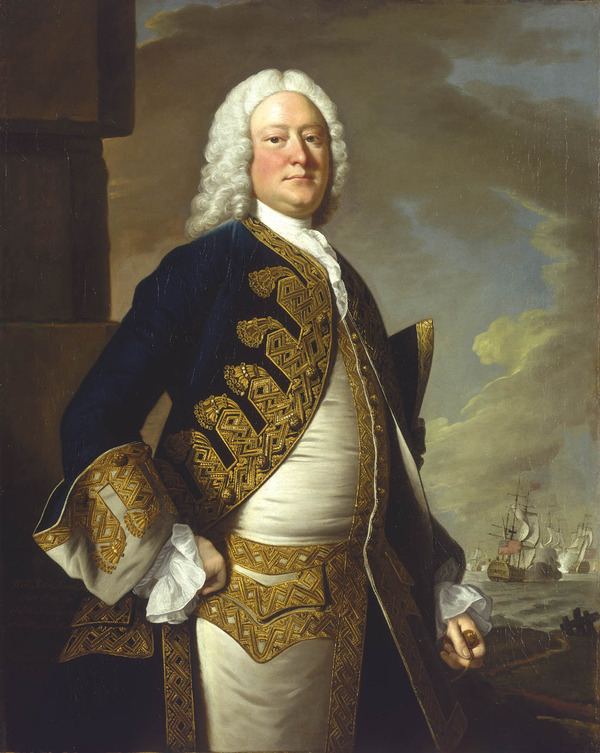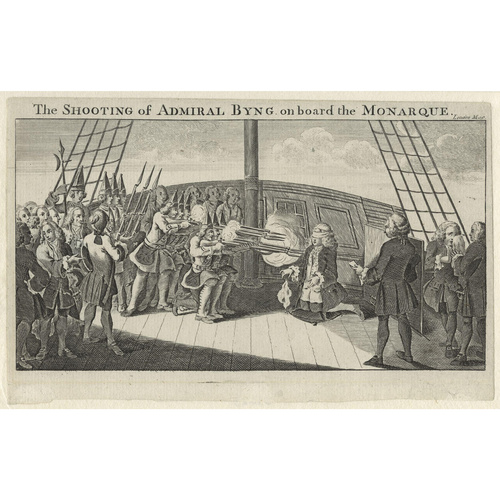
Source: Courtesy of Wikimedia Commons
BYNG, JOHN, officer in the Royal Navy, governor of Newfoundland; baptized at Southill, Bedfordshire, England, 29 Oct. 1704, son of George Byng, 1st Viscount Torrington, and Margaret Masters; d. 14 March 1757.
John Byng entered the navy in 1718 in the Superbe, serving in the Mediterranean. He was commissioned lieutenant in 1724, and promoted captain of the frigate Gibraltar in 1727; he remained on the Mediterranean station until 1739. He saw little action during these years.
Early in 1742 Byng was commissioned governor of Newfoundland, and arrived at St John’s on 18 June in command of the Sunderland. Seeking information on Newfoundland trade, he appointed William Keen Jr (see William Keen] as “Navall Officer” to receive the records of imports and exports and watch for illicit trade. Several merchants, however, protested they would never allow the masters of their ships to make the required returns. In his report of February 1742/43 Byng told the Board of Trade that the whole island, particularly St. John’s, was virtually a monopoly in the hands of three or four merchants who bought entire cargoes of ships as they arrived and sold the goods to the boat keepers and poor people at exorbitant prices. He had tried in vain to stop this practice and asked the board to devise some preventive measures.
As instructed Byng had collected statistical details on the cod and salmon fisheries and information on the living conditions of the local population. He reported there were many Irish “papists” on the island, mainly at Ferryland, who were peaceable and contented. The appointment of justices of the peace had been of great service in the island; the complaints of certain merchants in the west of England that the justices exceeded their powers seemed to be without foundation. He had heard of no murders or felonies. In general Byng seems to have been most conscientious in his administration of Newfoundland.
In August 1745, on the same day as Peter Warren, he was promoted rear-admiral, and commanded a squadron sent to the east coast of Scotland to prevent help and supplies reaching the insurgents who were supporting the Young Pretender’s attempt on the crown of England. He returned in 1747 to the Mediterranean, where he was made vice-admiral and commander-in-chief. In 1751 he was elected to parliament for Rochester.
Promoted admiral, Byng was sent in April 1756 with a weak and undermanned squadron to the Mediterranean to safeguard the British-held island of Minorca against a rumoured attack by the French. Byng had never led a fleet in a naval engagement or been part of an important action as commander of a vessel. On reaching Minorca he found Fort St Philip at Port Mahón besieged and a French squadron, under La Galissonière [Barrin], close at hand. His failure to relieve the fort, by not pressing home his attack on the French ships, led to his arrest and trial by court martial. Of several charges brought against him, including that of cowardice, only negligence was proved, and he was condemned to death. Despite efforts to save him by several prominent people, including Horace Walpole, he was executed by a firing squad on board the Monarch at Portsmouth on 14 March 1757.
Byng’s trial excited the sympathy of Voltaire, who wrote to him, and who remarked in his Candide that the English thought it good “to kill an admiral from time to time to encourage the others.”
PRO, Adm. 1/3878; CO 194/11, nos.60, 62; 195/8, nos.2–43. Charnock, Biographia navalis, IV. Sedgwick, History of parliament, I, 511. Dudley Pope, At 12 Mr Byng was shot . . . (London, 1962).
Cite This Article
Michael Godfrey, “BYNG, JOHN,” in Dictionary of Canadian Biography, vol. 3, University of Toronto/Université Laval, 2003–, accessed April 1, 2025, https://www.biographi.ca/en/bio/byng_john_3E.html.
The citation above shows the format for footnotes and endnotes according to the Chicago manual of style (16th edition). Information to be used in other citation formats:
| Permalink: | https://www.biographi.ca/en/bio/byng_john_3E.html |
| Author of Article: | Michael Godfrey |
| Title of Article: | BYNG, JOHN |
| Publication Name: | Dictionary of Canadian Biography, vol. 3 |
| Publisher: | University of Toronto/Université Laval |
| Year of revision: | 1974 |
| Access Date: | April 1, 2025 |




